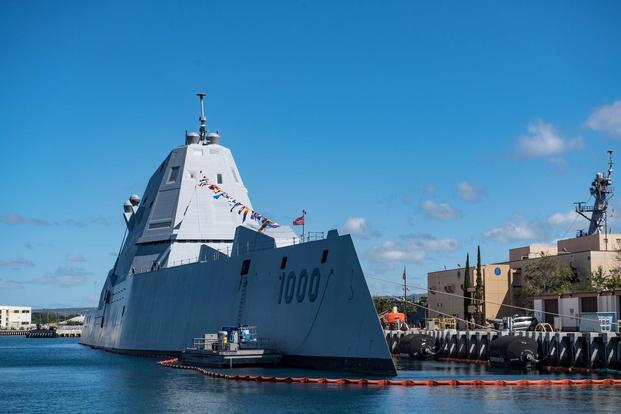NATIONAL HARBOR, Maryland -- Weapons testing is now in full swing for the Navy's new Zumwalt class of giant guided-missile destroyers.
As construction nears completion on the third and final ship in the class, the service is putting the Zumwalt's combat system through its paces, Capt. Kevin Smith, program manager for the class, explained Tuesday at the Navy League's Sea-Air-Space Expo.
Smith said the Zumwalt's combat system successfully conducted its first live missile firing with the RIM-162 Evolved Sea Sparrow Missile in late April, using the Navy's remote-control optional Self-Defense Test Ship to aid in simulating various threat profiles.
"We're going through all our unmanned firing testing," he said.
Related content:
- New Nuke Cruise Missile Could Go on Zumwalt-Class Destroyers: STRATCOM
- Navy's Stealthy Mega-Destroyer Still Doesn't Have a Round for Its Gun
- At $800K a Pop, New Navy Destroyer's Ammo Is in Question
No missiles have been fired yet from the ships themselves, but a test off the lead ship is coming, Smith said. The Navy plans to fire the Standard Missile-2 off the lead ship, the Zumwalt, sometime in the 2020 timeframe, he added.
"This is another way for us, very affordably, to try to get as much integration done in the hardware before we move to the ship and have all that maturity," he said.
Meanwhile, work and decision-making continues regarding the other weapons systems the ship will carry. The ships are set to carry the Tomahawk Land Attack Missile, but Smith said officials are looking at installing the Maritime Strike Tomahawk, capable of tracking moving targets at sea, as a modernization upgrade. Program managers are also looking at adding the Standard Missile-6 Block IA, an enhanced precision-guidance missile system.
As was widely reported, the custom 155mm Advanced Gun Systems designed for the Zumwalt hit a roadblock in 2018 when procurement for the Long Range Land Attack Projectile rounds the guns were supposed to fire was canceled due to cost concerns.
Smith said the guns remain "in layup" as the Navy explores its options.
"We're waiting for that bullet to come around to give us the longest range possible," he said. "Given that this is offensive surface strike, the land-attack part, we're going to look to the other capabilities potentially that we could use in that volume."
-- Hope Hodge Seck can be reached at hope.seck@military.com. Follow her on Twitter at @HopeSeck.












